It’s been a long time since I had a serious mission to accomplish at the plant. The past 5-6 visits were brief and mostly just to hang out. Nothing wrong with that, but I have longed for last winter when the sense of urgency was palpable at 6am as I lay in bed on my day off, buzzing with excitement (and metabolizing alcohol) and ready to head out.
On a work road trip recently in Kentucky, I got to divulging the bizarre story of my discovery of the plant to my friend and colleague Mike. Surprisingly, he was very interested and was something of a collector of industrial artifacts himself! It was a relief to talk to someone who really understood what the heck I’m doing out here as it is just so rare.
A few days later, I was sharing some photos of some of my artifacts including my B16 oven marker which I pulled out of the battery #1 basement months ago. I jokingly mentioned that I should go buy a battery powered angle grinder and scoop up all the signs down there. He immediately responded that he had one and he’d be glad to borrow it to me in exchange for a sign. The next day he sent me a tracking number – the tool was on the way.
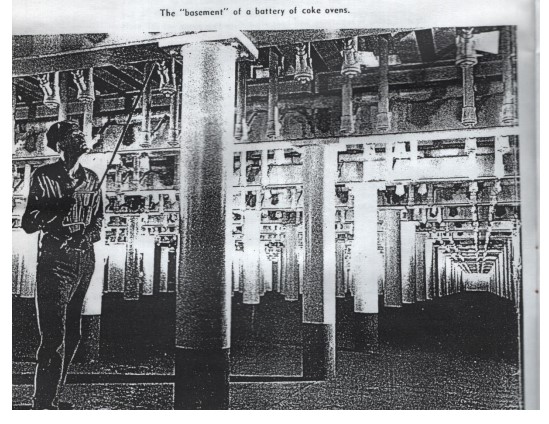
I made a list of tools to cover all my bases before I left. I made sure to wear boots because the last couple times I glanced down there, it was quite wet. Somehow when I explored it last year it was very dry. I even bought an impact screwdriver and became more and more convinced that this would be an even better solution that the angle grinder. I didn’t have my own bike so I just took a Divvy down. There is a sign post at 116th (ironically there is no longer a sign on it, maybe there was once a bus route that went further south on Torrence?). I locked up and walked down to the quench station and find my familliar hole in the fence.
I didn’t waste much time before I headed down into the belly of the beast. I had a plan to grab three signs:
- B25. I had wanted this one all along (back when I grabbed B16). To me it signifies that not only did I explore the basement, but I made it all the way to the north end through the all consuming void of darkness and silence.
- A1. I figured if I have the tools to take signs easily, I should take more than one. I figured the first and last signs would make a good pair
- A16. I decided to give Mike B16 (he expressed an interest in having corresponding A and B signs) and this would be it’s mate.
The pusher side of the basement had a couple inches of water which is odd since it has not rained in sometime. It wasn’t deep enough to make working impossible, but since there are signs on both ends of the ovens, might as well work on the coke sign and not stand in a puddle. I went over to A1 and instantly saw that the screws are hex heads so my impact screwdriver was useless – a simple socket might have been all I needed. Then again, every screw I looked at was pretty badly rusted and I might have just worn the corners off the bolt after the first turn, so in the end the angle grinder was probably the best solution.
The sign at B25 came off pretty easily. There is an ‘E’ appended to the name which I don’t understand – perhaps this just means ‘end’? I’d think it was ‘east’ (coke side) but I know the pusher side sign also has the ‘E’. At any rate, I moved on to snag A16 and A1 and got the hell out of there.
I decided to do a little exploring and went back to the storehouse and the offices on the east side of the building. When I made my night time visit, I found some FR (both jacket and pants) and the jacket looked like it might actually be salvageable after some washing. I couldn’t inspect it very well in the dark with a flashlight and I have been meaning to go back.
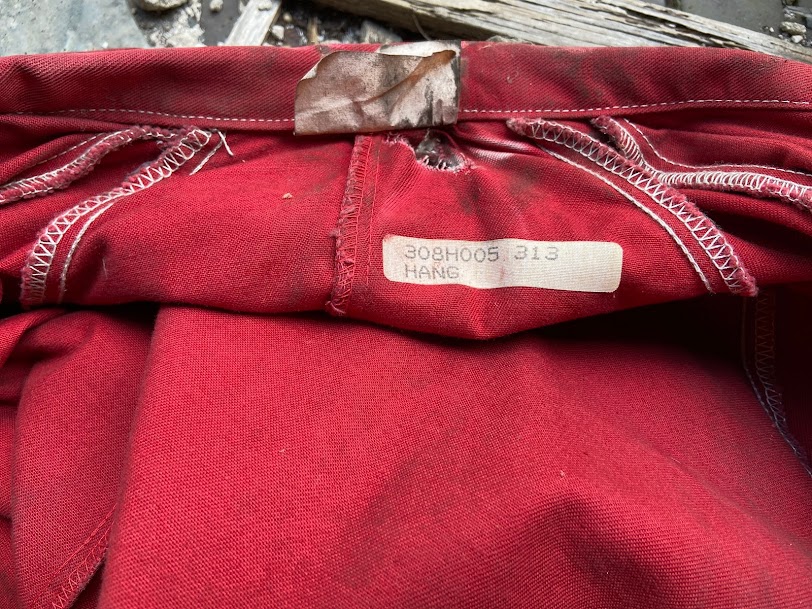
These are the best FR garments I have found around the plant. The pants were a 36 waist so a bit small for me but I grabbed the jacket. There is hole near the collar where the hook it has hung on for 20 years+ has eventually pushed its way through the fabric. I brought it back and washed it by hand in a mop bucket with cold water and some Simple Green. This got it substantially cleaner and I thought maybe I had a shot to save this jacket. However the biggest issue is that although it was mostly out of the elements inside a building (not exposed to rain or snow), the folds of the jacket where it hung on the wall caused some severe UV damage (turned the red fabric white) and those areas are very fragile. I accidentally tore a part under the arm but I did finish washing, rinsing and wringing (using the mop wringer) and I have it hung up on a hanger to dry. I know I cannot reverse the UV damage but I don’t care about the color change, probably impossible but some way to put the ‘life’ back into these areas so they wouldn’t be so fragile would be a solution. For now it can dry on a hanger and I’ll have a look and see what can be done going forward. Still a fun experiment.
I looked around and also found some interesting shipping documents in the same office – grabbed one (see below). This is interesting because it still used Interlake letterhead in 1991. I guess they were just using up old documents? Would definately create some confusion however when invoices were sent (as Acme would be paying the bill). Chromalox is still around and makes industrial heating systems.
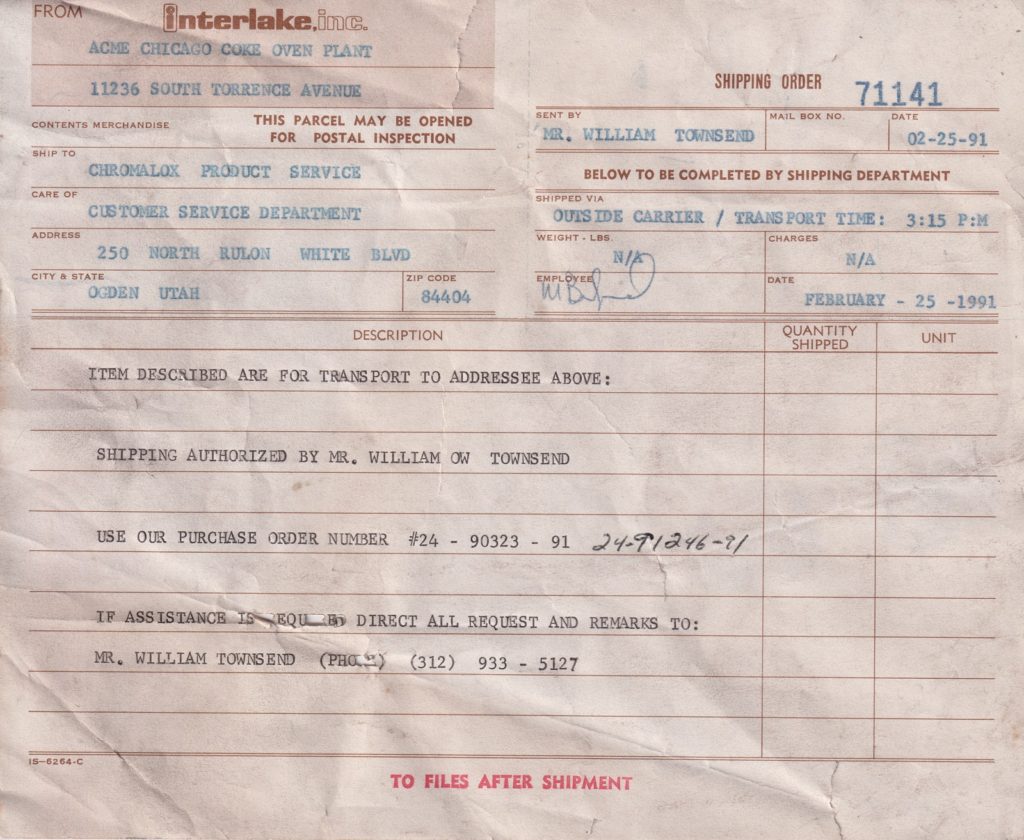
I also found what seems to be microfiche (microfilm is in a roll, microfiche is a flat sheet). There were two of them and they are in very good condition even though the envelope they were in was almost destroyed with some red ink from an ink pad I also found. But the microfiche just wiped clean.
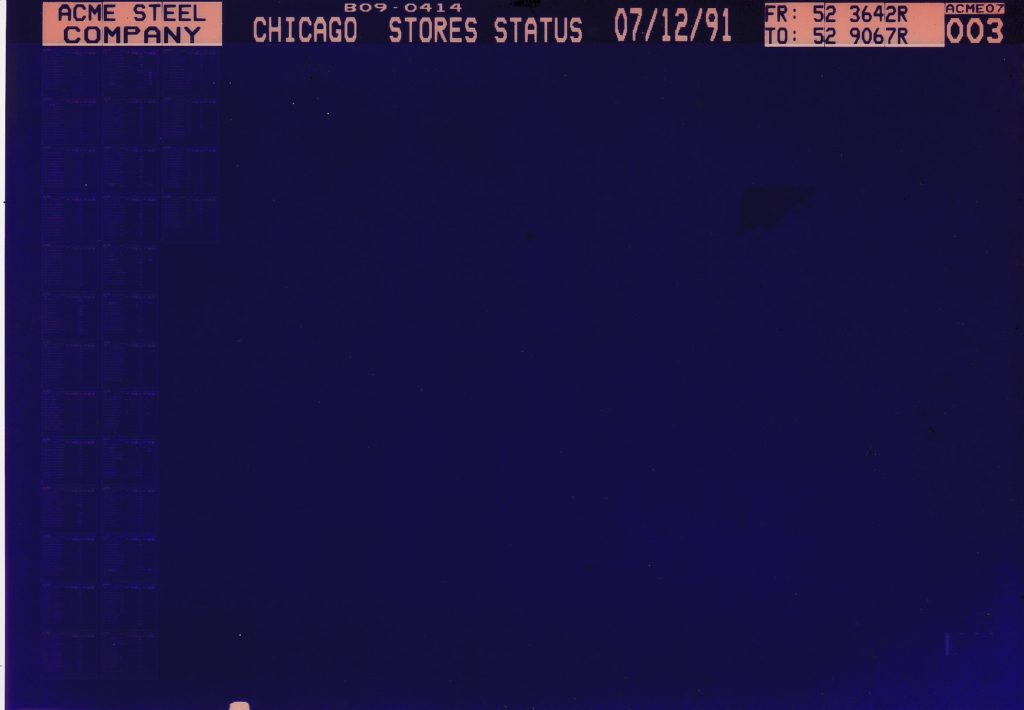
I did some research and I should be able to read what these say using a regular flatbed scanner if I can scan it at high enough DPI. My scanner (Canon LIDE 300) can scan at 2400. It isn’t quite high enough to read it easily but it works just fine. The biggest issue is that if the flatbed glass and the media isn’t very clean, everything shows at this resolution. And the more I tried to clean it it only seemed to get worse!
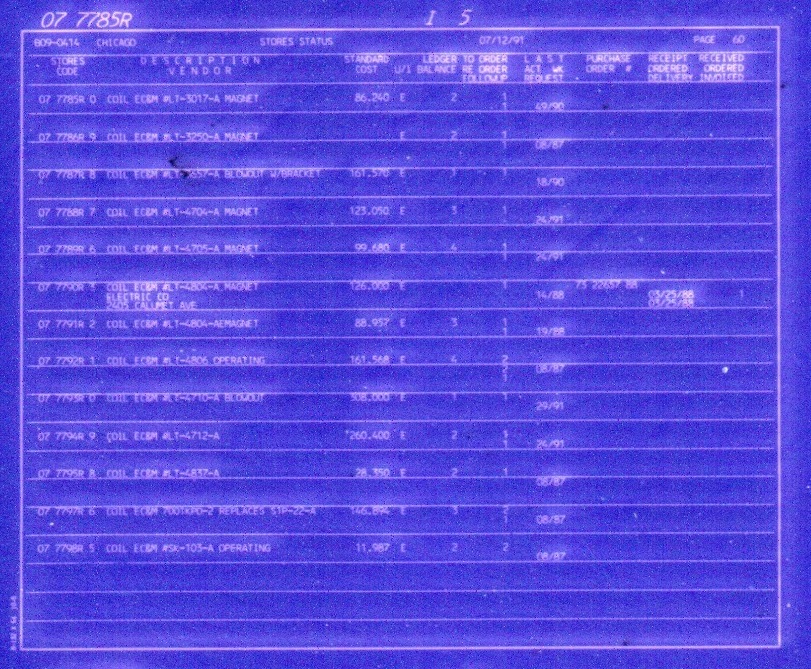
And below are the full size scans of the two pieces of microfiche I have. I will have to continue to search the storehouse, I may find more.
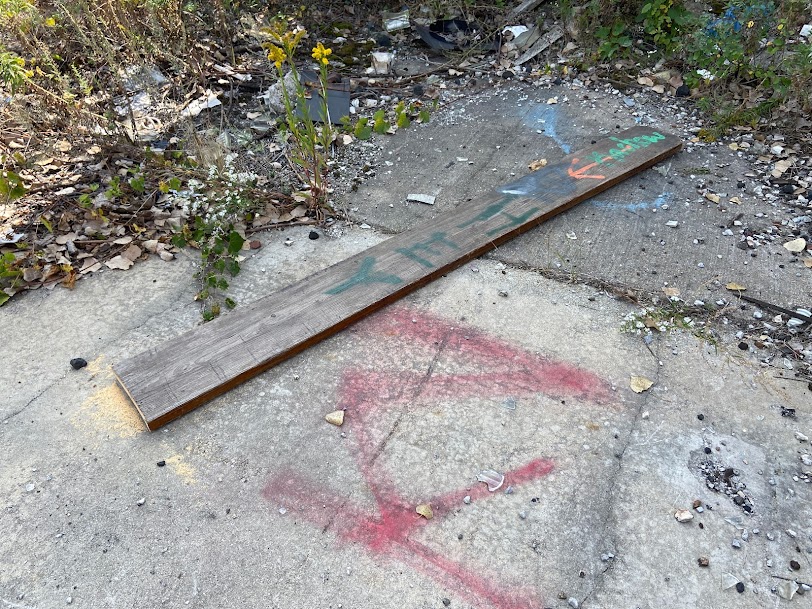
I offered Mike the benzene sign near the gate house (I believe this was the light oil building?) and he was game. I got it down easily enough with the grinder and a couple massive centipedes ran out from under it.
The problem of this sign’s size quickly arose however, as it is too large not only for my backpack but even for the bike rack on the Divvy. It always pays to keep a few carabiners and some lengths of paracord in your bag, Problem solved! Only issue was that when I picked up some speed it lifted up like a sail. But it stayed intact.
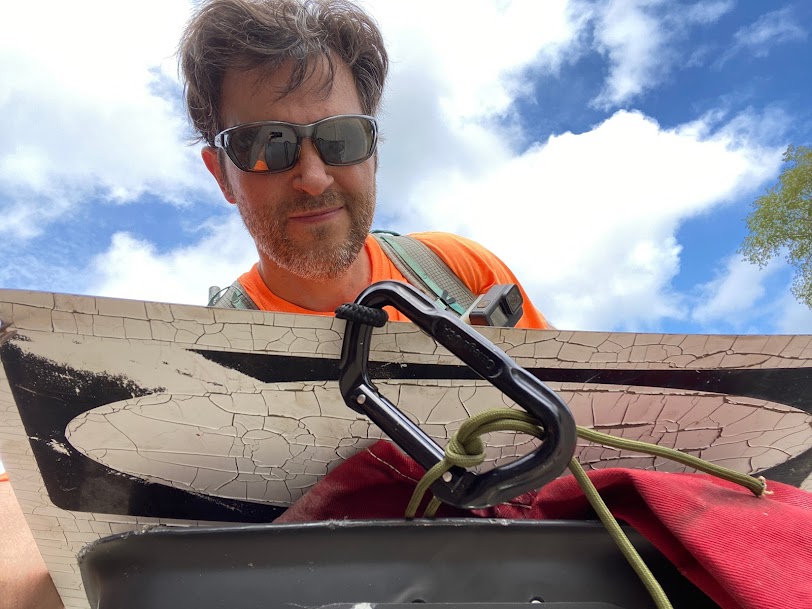
On the way out, I was looking for the fence opening back onto Torrence when I came upon one of the tar pits I’ve seen before. However this one was especially active. Tar is like some grudges – never goes away. I hope we can say the same of the coke plant for years to come!
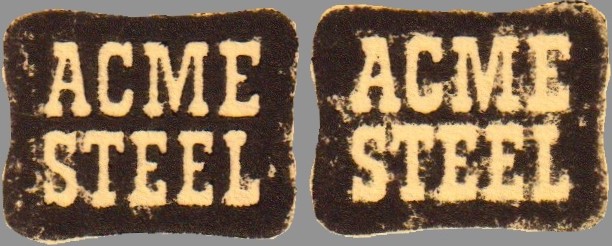
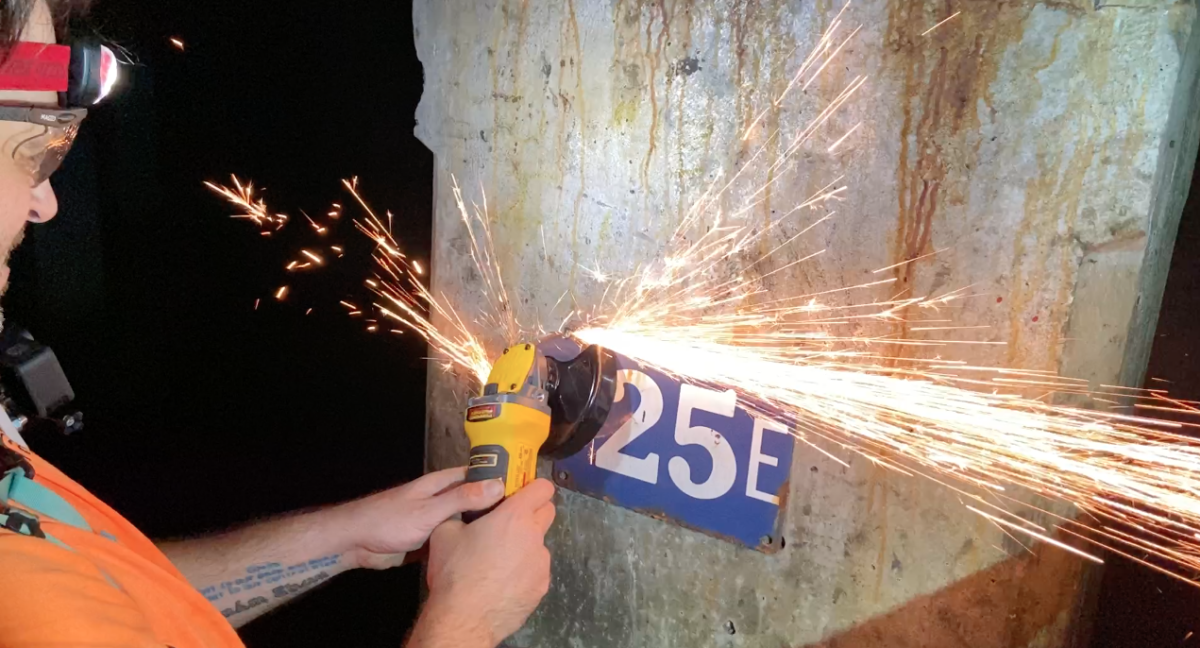
2 replies on “Battery #1 basement”
Good to see you made it out from under that crumbling wreck and back into the land of the living. Nice job on executing your plans.
Thank you so much for watching and commenting!